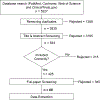Systematic Review and Meta-Analysis of Endovascular Therapy Effectiveness for Unruptured Saccular Intracranial Aneurysms
- PMID: 38846323
- PMCID: PMC11152505
- DOI: 10.1161/SVIN.123.001118
Systematic Review and Meta-Analysis of Endovascular Therapy Effectiveness for Unruptured Saccular Intracranial Aneurysms
Abstract
Background: Currently, endovascular treatment of intracranial aneurysms (ICAs) is limited by low complete occlusion rates. The advent of novel endovascular technology has expanded the applicability of endovascular therapy; however, the superiority of novel embolic devices over the traditional Guglielmi detachable coils (GDCs) is still debated. We performed a systematic review of literature that reported Raymond-Roy occlusion classification (RROC) rates of modern endovascular devices to determine their immediate and follow-up occlusion effectiveness for the treatment of unruptured saccular ICAs.
Methods: A search was conducted using electronic databases (PUBMED, Cochrane, ClinicalTrials.gov, Web of Science). We retrieved studies published between 2000-2022 reporting immediate and follow-up RROC rates of subjects treated with different endovascular ICA therapies. We extracted demographic information of the treated patients and their reported angiographic RROC rates.
Results: A total of 80 studies from 15 countries were included for data extraction. RROC rates determined from angiogram were obtained for 21,331 patients (72.5% females, pooled mean age: 58.2 (95% CI: 56.8-59.6), harboring 22,791 aneurysms. The most frequent aneurysm locations were the internal carotid artery (46.4%, 95% CI: 41.9%-50.9%), the anterior communicating artery (26.4%, 95% CI: 22.5%-30.8%), the middle cerebral artery (24.5%, 95% CI:19.2%-30.8%) and the basilar tip (14.4%, 95% CI:11.3%-18.3%). The complete occlusion probability (RROC-I) was analyzed for GDCs, the Woven EndoBridge (WEB), and flow diverters. The RROC-I rate was the highest in balloon-assisted coiling (73.9%, 95% CI: 65.0%-81.2%) and the lowest in the WEB (27.8%, 95% CI:13.2%-49.2%). The follow-up RROC-I probability was homogenous in all analyzed devices.
Conclusions: We observed that the coil-based endovascular therapy provides acceptable rates of complete occlusion, and these rates are improved in balloon-assisted coils. Out of the analyzed devices, the WEB exhibited the shortest time to achieve >90% probability of follow-up complete occlusion (~18 months). Overall, the GDCs remain the gold standard for endovascular treatment of unruptured saccular aneurysms.
Keywords: Guglielmi detachable coils; Woven EndoBridge; endovascular therapy; flow diverters; intracranial aneurysms.
Figures


References
-
- Guglielmi G, Viñuela F, Dion J, Duckwiler G. Electrothrombosis of saccular aneurysms via endovascular approach: Part 2: Preliminary clinical experience. Journal of Neurosurgery. 1991; 75: 8–14. - PubMed
-
- Guglielmi G, Vinuela F, Sepetka I, Macellari V. Electrothrombosis of saccular aneurysms via endovascular approach. Part 1: Electrochemical basis, technique, and experimental results. Journal of Neurosurgery. 1991; 75: 11–17. - PubMed
-
- Claiborne JS, Wilson CB, Halbach VV, Higashida RT, Dowd CF, McDermott MW, Applebury CB, Farley TL, Gress DR Endovascular and surgical treatment of unruptured cerebral aneurysms: Comparison of risks. Annals of Neurology. 2000; 48: 11–19. - PubMed
-
- Molyneux AJ, Kerr RS, Yu L-M, Clarke M, Sneade M, Yarnold JA, Sandercock P. International subarachnoid aneurysm trial (ISAT) of neurosurgical clipping versus endovascular coiling in 2143 patients with ruptured intracranial aneurysms: A randomised comparison of effects on survival, dependency, seizures, rebleeding, subgroups, and aneurysm occlusion. Lancet, 2005; 366: 809–817. - PubMed
Grants and funding
LinkOut - more resources
Full Text Sources
Miscellaneous
